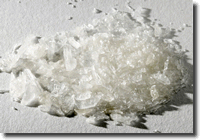About Meth
- What is Meth
- Effects of Meth
- Meth Users
- Signs of Meth use
- Meth Addiction
- Meth Withdrawal
- Meth Overdose
- Meth Addiction Treatment
- Facts About Meth
- Meth Statistics
- Meth Labs
- Meth Ingredients
- Crystal Meth
- Cost of Meth
- Meth Side Effects
- Smoking Meth
- Injecting Meth
- Snorting Meth
- What Does Meth Smell Like
- What Does Meth Look Like
- Meth Mouth
- Meth Sores
- Meth Pictures
- Meth User Pictures

What Does Meth Look Like?
 What does meth look like? Meth is an opaque powder with slightly varying hues like yellowish or even lightly pink. Crystal Meth (also called shards, glass, ice...) forms as clear crystals resembling natural quartz formations but on a much smaller scale. The color may vary from yellowish, orange, pinkish, cloudy and totally clear. The crystals themselves may be broken and almost powdery or it can still be in one larger formation. Meth is brittle to the touch and will crumble with too much handling.
What does meth look like? Meth is an opaque powder with slightly varying hues like yellowish or even lightly pink. Crystal Meth (also called shards, glass, ice...) forms as clear crystals resembling natural quartz formations but on a much smaller scale. The color may vary from yellowish, orange, pinkish, cloudy and totally clear. The crystals themselves may be broken and almost powdery or it can still be in one larger formation. Meth is brittle to the touch and will crumble with too much handling.
Let’s continue to look at the question, what does meth look like? It generally comes in three forms:
- What does meth look like? Powder: a white, odorless, and bitter-tasting crystalline powder, readily soluble in water or alcohol.
- What does meth look like? Crystal: Users smoke chunks of a very pure form of crystalline methamphetamine called “Ice”.
- What does meth look like? Rock: Big chunks of the drug, usually found in yellow, are usually ingested orally.
What does meth look like and how is it used?
Methamphetamine can be smoked, injected intravenously, snorted, or ingested orally. The drug alters mood in different ways, depending on how it is taken. Immediately after smoking or intravenous injection, the user experiences an intense “rush” or “flash” that lasts only a few minutes and is described as extremely pleasurable. Smoking or injecting produces effects fastest - within 5 to 10 seconds. Snorting or ingesting orally produces euphoria - a high but not an intense rush. Snorting produces effects within 3 to 5 minutes, and ingesting orally produces effects within 15 to 20 minutes.
Meth is a powerfully addictive stimulant that has a dramatic effect on the central nervous system. Essentially, meth tricks the brain and body into thinking that it has limitless stamina while in fact draining critical energy reserves needed to maintain the body's vital organs and functions. As a consequence, meth produces bursts of energy and euphoria but ultimately leads to severe depression, brain damage, physical deterioration, and – in some cases – violent paranoia.
Meth is a stimulant – a drug that increases the energy of the user. Caffeine is a very mild stimulant, while cocaine and methamphetamine are more intense, addictive, and dangerous stimulants. Stimulant drugs such as meth and cocaine may be contrasted with narcotic drugs like heroin and morphine, which do not stimulate the nervous system but instead tend to dull the senses and induce relaxation, stupor, and sleep.
Persons who violate the law by making, possessing, or distributing meth often break the law in other ways as well – because of or in support of their meth habit. Many law enforcement agencies will point to a connection between meth makers and meth addicts and crimes such as: homicide, domestic abuse, illegal possession of handguns, theft and identity theft. A recent survey of the inmates in the Nevada Department of Corrections facilities in early 2007 found that meth was a factor in the crimes of 40% of incarcerated men and 72% of incarcerated women.
More about meth…
- Persons driving under the influence of meth cause traffic accidents, imposing costs on insurance companies and – ultimately – their customers, as well as police departments, fire departments, emergency rooms, and other medical providers.
- Fire departments must bear the cost of responding to the many fires and explosions caused by meth lab accidents.
- Physical problems caused by meth lead meth addicts – most of them without resources or insurance – to seek medical help in local emergency rooms and publicly-financed healthcare facilities.
- Social problems caused by meth use have overwhelmed public and private social service providers.
- Schools face added costs involved in educating the children of meth addicts, many of whom have suffered physical, emotional, and psychological harm stemming from their parents’ behavior.
- Because meth users are usually indigent, the cost of caring for children born to meth-addicted mothers ultimately falls on taxpayers.
- Widespread theft of meth-making materials such as cold medications and lithium batteries has imposed additional costs on retailers throughout Nevada.
- As meth addiction spreads, employers throughout the state must deal with employees who are too sick to work effectively or work at all. Like other drug users, meth addicts account for significant levels of workplace theft, tardiness, low productivity, and high turnover.
- Similarly, meth addicts are more likely to cause workplace accidents than their counterparts.
